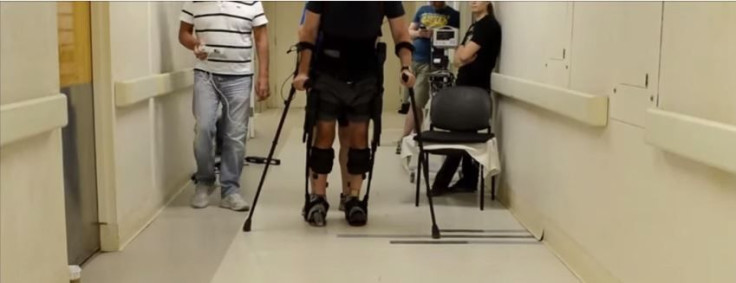New Paralysis Therapy Uses Ekso Bionics Suits To Help Patients' Voluntarily Move Their Leg Muscles, Increase Muscle Tone

Mark Pollock, 39, is the first completely paralyzed man to voluntarily move his leg muscles while wearing a bionic suit, a team of scientists at the University of California, Los Angeles reported.
Pollock, a blind man who was left completely paralyzed after falling from a second-story window in 2010, successfully used the suit to take thousands of steps during five days of physical training, which he then repeated two weeks afterward. UCLA reported that Pollock has regained enough voluntary control of his legs to actively use the device to help him enhance his mobility. But it’s not just the device that’s helped Pollock improve his leg movements; he also underwent a noninvasive spinal stimulation technique that improved his muscle movement, cardiovascular function, and muscle tone.
The spinal technique is formally known as transcutaneous spinal cord stimulation, or ElectriRx; it’s applied to selected sites over the spinal vertebrae during a week of training. UCLA scientists found that with this stimulation, Pollock (and likely others) could enhance the level of effort in the bionics suit.
“Stimulation improved the coordination patterns of the lower limb muscles resulting in a more continuous, smooth stepping motion in the exoskeleton,” the scientists explained. “These stepping sessions in the presence of stimulation were accompanied by greater cardiac responses and sweating than could be attained without the stimulation. Based on the data from this case study, it appears that there is considerable potential for positive synergistic effects after complete paralysis by combining the overground stepping in an exoskeleton.”
As far as UCLA is concerned, these findings, as proved by Pollock, are the first of their kind. This method is able to provide painless stimulation using special kinds of electrical pulses at a high frequency in order to help those with chronic paralysis. But scientists are wary to say these patients are “walking” again — no one who is completely paralyzed has been able to do so without a proper suit and stimulation.
Even so, these are pretty monumental findings.
“In the last few weeks of the trial, my heart rate hit 138 beats per minute,” Pollock said. “This is an aerobic training zone, a rate I haven’t even come close to since being paralyzed while walking in the robot alone, without these interventions. That was a very exciting, emotional moment for me, having spent my whole adult life before breaking my back as an athlete.”
While Pollock has gained back some of his voluntary muscle movement, he hasn’t let his disabilities stop him from entering endurance races. Since he first lost his sight in 1998, he has competed in several races across deserts, mountains, and the polar ice caps, and won silver and bronze medals in rowing during the Commonwealth Games in Glasgow, UK.
The bionics suit is a battery-operated suit that enables paralyzed patients to move their legs in a step-like fashion; it’s manufactured by the California-based company Ekso Bionics. Scientists believe they’re seeing “a surge of momentum” in the field of spinal cord research.
“For people who are severely injured but not completely paralyzed, there’s every reason to believe that they will have the opportunity to use these types of interventions to further improve their level of function. They’re likely to improve even more,” said senior study author V. Reggie Edgerton, a professor of integrative biology and physiology, neurobiology and neurosurgery at UCLA. “We need to expand the clinical toolbox available for people with spinal cord injury and other diseases.”
Watch Pollock discuss his journey more in the video below:
Source: Edgerton VR, et al. Iron ‘ElectriRx’ man: Overground stepping in an exoskeleton combined with noninvasive spinal cord stimulation after paralysis. IEEE Engineering in Medicine and Biology Society. 2015.
Published by Medicaldaily.com



























